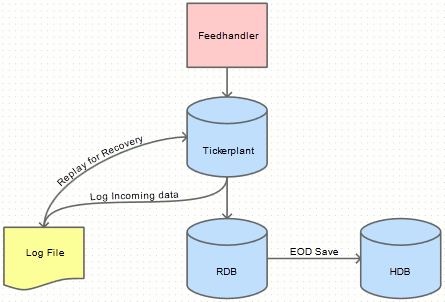QStudio
Query kdb+ Servers and Chart Results.
Kdb+Tick is a standardised architecture by kx for storing, analysising and retrieving tick data. The product provides a framework for subscribing to data, distributing the data to your C++/Java processes and storing it efficiently long term.

A kdb+tick system consists of the following components
A feedhandler subscribes to data from an exchange, processes, cleans, normalizes the data and sends it to a kdb tickerplant. Examples of kdb java feedhandlers and C feedhandlers are available.
.u.init,.u.del,.u.sel,.u.pub,.u.add,.u.sub,.u.end.u.endofday - Handles end of day saving data down and starting new log.override .z.ts - To publish updates to subscribers in a timed loop.u.upd - Accepting data updates from feedhandlers, adding time column where needed and buffer for later publishing..u.end - Save RDB contents to HDB directory at end of day..u.rep - Replay log file, goto HDB directory..u.upd - Accept updates by inserting into in memory table..u.upd[tableName; tableData] accepts two arguments, for inserting data to a named table. This function will normally be called from a feedhandler. It takes the tableData, adds a time column if one is present, inserts it into the in-memory table, appends to the log file and finally increases the log file counter.
.u.sub accepts two arguments, the first argument is the tables that you want to subscribe to, the second is a list of syms that you are interested in. Once this function has been called, the remote process will receive any updates on them tables for the selected lists of syms. An empty symbol ` for any argument acts as a wildcard and returns data for all tables r syms.
At end of day (when the date changes) a special sequence of events occurs, in order to save the data from the RDB to the HDB etc.
.Q.hdpfQuery kdb+ Servers and Chart Results.